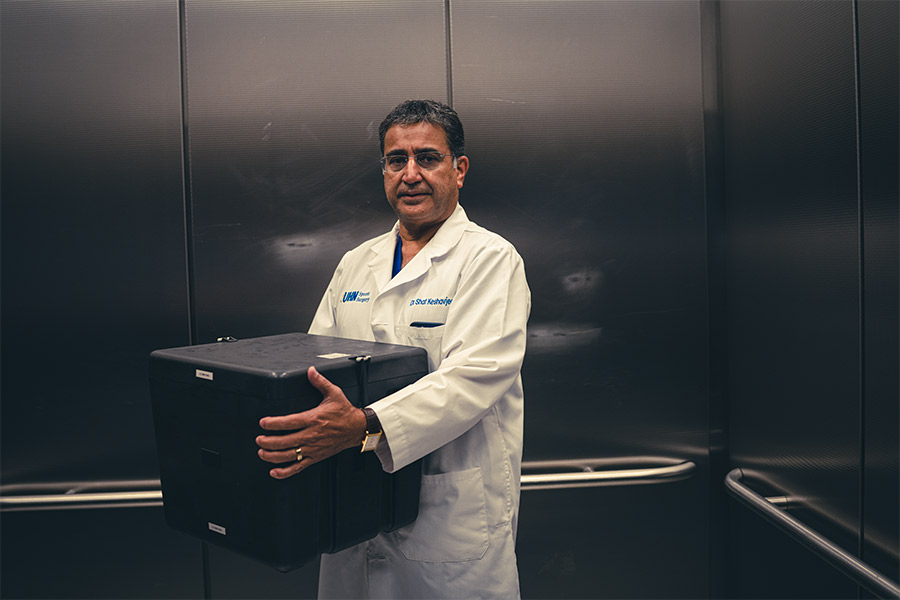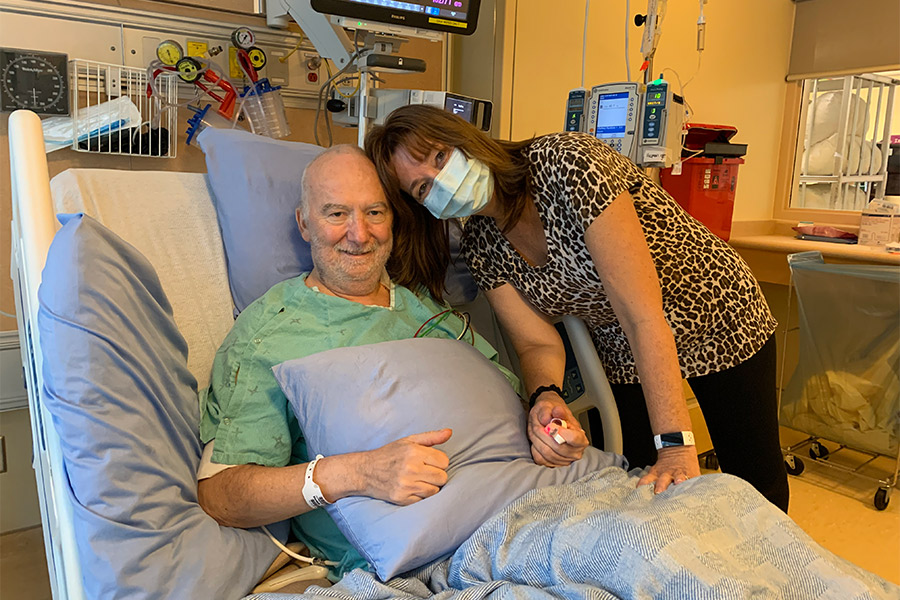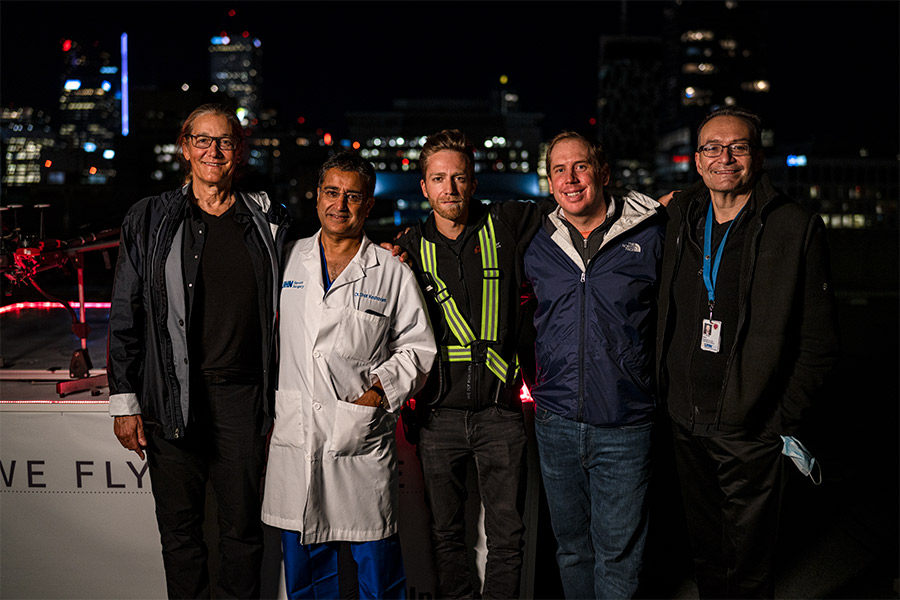As a proof of concept, this world-first flight is a first step to revolutionize organ transportation systems. (Photo: Unither Bioélectronique).
In an exciting world-first, lungs intended for transplant were transported by an unmanned aerial drone from UHN’s Toronto Western Hospital to Toronto General Hospital. The few-minutes flight happened in late September and was led by the Toronto Lung Transplant Program in partnership with Quebec-based biotechnology aviation company Unither Bioélectronique, with support from Trillium Gift of Life Network (TGLN) – the organization in charge of organ and tissue donation in Ontario.
“This is an incredibly important milestone for our program, and for the medical field of transplantation,” says Dr. Shaf Keshavjee, Director of the Toronto Lung Transplant Program at UHN’s Ajmera Transplant Centre.
As a proof of concept, this flight is a first step to revolutionize organ transportation systems. The use of drones and autonomous aircrafts have potential to make organ transportation faster, more cost-effective, greener and, most importantly, it will help save more lives.
“If we want to save more lives, part of the solution is to create new, more efficient ways to get lungs and other organs to patients who need them the most,” says Dr. Keshavjee.
There is a chronic shortage of organs available for transplant. For lungs, around 20 per cent of patients in Canada die on the waitlist, and part of the issue is a result of logistical barriers.
“Many times, we lose a life-saving organ because we can’t get to it in time, or we can’t get it back before the organ deteriorates and is no longer suitable for transplant,” explains Ajmera Transplant Centre’s Medical Director, Dr. Atul Humar.
“Having drones to transport lungs and other organs across the continent would help move them faster and more efficiently. In the long-term, this would also contribute to transporting them seamlessly to and from highly specialized organ repair centres like the Ajmera Transplant Centre in Toronto.”
More organs and improved organs
A focus of the research conducted by the Ajmera Transplant Centre and the Toronto Lung Transplant Program is to improve both the number of organs available for transplant, and their quality.
A leader in developing the Ex Vivo technology, the Centre collaborates with industry partners like Unither – a subsidiary of United Therapeutics Corporation – to develop cutting-edge solutions and lead innovations that will have a direct impact in patient care.
“Our company is dedicated to creating an unlimited supply of transplantable organs for everyone who needs it, and we are confident that drone transportation will play an important role in achieving this goal,” says Martine Rothblatt, CEO, United Therapeutics.
“We are very proud of this world-first in partnership with the Toronto Lung Transplant Program at UHN, a world leader in lung transplantation where the first successful single and double-lung transplants were performed in the 1980s.”
This important achievement could not have happened without the critical support from Ontario Health’s Trillium Gift of Life Network (TGLN).
“The strong connections we have with hospitals across the province are critical to the success of Ontario’s organ donation and transplant system, which is recognized as one of the best in the world,” says Clare Payne, Vice-President, Clinical Transplant Systems at TGLN.
“We are excited to see advances in drone and automated aircraft transportation as it has potential to improve accessibility to donated organs. We are so grateful to donors and their families and welcome all opportunities that could improve access to their life-saving gifts.”

Flying precious cargo in an urban setting
The Unither and UHN team created a special cooler to transport the lungs with the drone. This container made of light carbon fiber was rigorously tested to ensure the organ would be protected from vibration, changes in temperature, pressure or other environmental factors.
“We knew we would essentially be carrying a human life, so we needed to ensure the flight was safe for the organ, as well as for the thousands of people on the ground,” says Mikael Cardinal, Vice-President, Program Management – Organ Delivery Systems at Unither.
A major part of the project was to prove that it is possible to move an organ using a drone, and that it can be done safely in a densely populated area like downtown Toronto.
Under Transport Canada and Nav Canada oversight, UHN’s Surgility Program – a program within the Techna Technology Development Team that tackles technology challenges and innovation opportunities across UHN – worked with Unither through dozens of test flights prior to transporting the donor lungs. They developed take-off and landing protocols in each hospital, optimized processes and accounted for human and weather variables.
The teams also worked closely with UHN Security and Facilities to install landing pads on the rooftops of TGH and TWH, improve routes and access to the buildings, and create a clear, safe path to and from the operating rooms.

Contributing to medical advances
Patient Alain Hodak, who received the first lungs ever transported by a drone, was excited to be part of this project. A few days after his transplant, he was recovering well and proud to play a role in a world-first.
“It’s an honour to be a part of such an amazing leap in technology that will make organ transportation better and faster. As an engineer, I find it thrilling to be part of this major advance in science and medicine.”
Alain and his family are also incredibly grateful to the organ donor and their family.
“They gave us the biggest gift our family could ever receive, giving Alain a second chance at life,” says the patient’s wife, Suzanne Côté-Hodak.
All partners on this historic project gratefully acknowledge the generosity of all organ donors and their families.
* Exact date of transplant is not being published to protect organ donor confidentiality.

